 |
|
Director/Cinematographer/Editor:Hiroshi Moriya
Released in 2011 (Final version), 114 min.
|

"TOKYO Ainu" Film Production Committee |
 |
| TOKYO Ainu features the Ainu, an indigenous people of Japan, living in Greater Tokyo
(Tokyo and its surrounding areas), who are and actively in promoting their
traditional culture in a metropolitan environment away from their traditional
homeland, Hokkaido. Shedding a common assumption that all Ainu live in
Hokkaido, the film captures the feelings, thoughts and aspirations of Ainu
people that who try to follow the Ainu way no matter where they live. |
TOKYO Ainu Promotional Footage (You Tube))  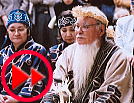
|
  |
“Make an Ainu movie for us! "
"Please document our voices for future generations!”
|
The entire project was set in motion by these passionate words from a huci (female Ainu elder), one of the approximately 5,000 to 10,000 Ainu living
in Greater Tokyo.
In 1872, the Hokkaido Aboriginal Training School was established in present-day
Shiba in Minato-ku, Tokyo, and 38 Ainu were forcibly brought from Hokkaido
to study there. For more than 130 years since then, many Ainu have migrated
from Hokkaido to Greater Tokyo for various reasons, such as to look for
jobs and to escape the racism in Hokkaido.
|
Many of them struggled to make a living in new and difficult surroundings,
turning their back on their Ainu identity. In 1972 one of these Ainu wrote
a letter to a newspaper, urging solidarity among the Ainu living in Greater
Tokyo. The letter caught the attention of some fellow Ainu, motivating
them to work together. Thus the Tokyo Utari Association, and with it the Ainu movement in Greater Tokyo, were born.
|
|
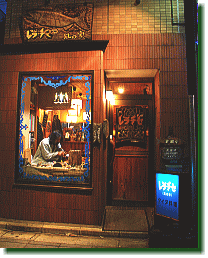
Rera-Cise (Nakano, Tokyo)
(Photo Isamu Sekito)
|
The movement began to gather forces in the 80s, and went into full swing
in the 90s with such notable events as the opening of an Ainu restaurant,
Rera-Cise (House of Wind). Now in the 21st Century, the torch is being passed to
the younger generations of Ainu, including such groups as the Ainu Rebels, among others.
[NOTE] Rera-Cise closed in November 2009.
*Ainu associations in Greater Tokyo
|
“The Ainu live in the 21st Century, still remembering our elders freely
roaming the wilderness of Hokkaido with a deep ingrained sense of harmony
with nature. I would like to have the flesh and blood and the voices of
these contemporary Ainu be documented in a film which will look into the
heart of the Ainu living in this moment and weave their aspirations for
the future.”
Driven by these words from a huci, the film production committee was established, and in the course of its
initial planning, was fortunate to find a director most appropriate for the film. Shooting for the film commenced in the spring of 2007, focusing on Haruzo Urakawa, who had been single-handedly building an Ainu cultural facility, called
“Kamuy Mintara” (“a garden where Ainu gods play” in the Ainu language) in Kimitsu, Chiba
Prefecture. The film was tentatively titled “Haruzo, an Ainu”.
|
[NOTE] the Ainu language has no written alphabet. When using the English
alphabet to write Ainu words, the letter "c" represents a "ch"
sound.
(ie "huci" is pronounced "hu-chi, "cise"->
"chi-se", "caranke"-> "cha-ran-ke")
|

|
  |
As the shooting progressed, many “ukocaranke” (meaning debate/discussion in the Ainu language) took place among the
committee members as well as with individual Ainu who were to appear in
the film. As a result, the film’s focus was changed to include the whole
Ainu community in Greater Tokyo and consequently the title was changed
from “Haruzo, an Ainu” to “TOKYO Ainu”.
|
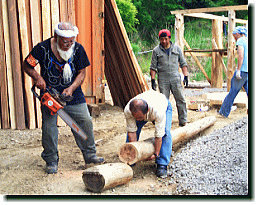 |
The film consists of interviews with those active in the Ainu community
in Greater Tokyo, interspersed with footage showing their activities as
Ainu as well as their daily life in mainstream Japanese society, thus documenting
the true-to-life reality of a contemporary ethnic Ainu community in Greater
Tokyo.
The film aims to show how the aspirations of each individual Ainu has been
formed in the context of the history of the Ainu movement in Greater Tokyo,
and how he or she has inherited the aspirations of their ancestors.
|
The history of the Ainu movement in Greater Tokyo is also the history of
individual Ainu trying to retain the memory of their ancestors and at the
same time exploring new identities. The film is one large tapestry woven
with stories told by those people who have tried to live as Ainu - stories
locked away deep in their hearts.
Facing this tapestry of stories, observing and listening to it with untainted
eyes and ears, will undoubtedly provide an important clue as to how we
Japanese should live in a multicultural society.
|

|
  |
References to the Ainu people, who were the inheritors of the Neolithic Jomon Culture, began to appear in Japanese documents in the seventh and eighth century. “I” in the title “Sei-i-daishogun” (warlord in charge of conquering barbarians) conferred to warrior chiefs
by the Imperial Court refers to the people in the North, mainly the Ainu,
who did not comply with the authority at the time. In the Edo Period, when
“Kitamae-sen” merchant ships crowded the ports bringing the wealth of the North, Ainu
men were exploited as laborers and Ainu women were abducted, resulting
in the collapse of Ainu families and communities. Many of these cases were documented.
It was in the second year of Meiji (1862) that the Colonizer’s Office was
established and the Ainu land hitherto called “Ezo” was renamed as "Hokkaido". This vast northern land became a frontier/domestic colony to firm up
the financial foundation of the new Meiji Government. Trying to catch up
with the Western Powers with a slogan of industrial development, the Government
needed to develop Hokkaido as a base to supply resources such as timber,
agricultural and fishing products and minerals.
For this purpose, the Meiji Government arbitrarily decided the Ainu land
as terra nullius, and seized it without consulting the Ainu, and the land
was given away or sold at very low prices to Japanese. The Ainu, on the
other hand, were entitled to only a tiny portion of the remaining vast
government-owned land paternally allotted to them as “grant land to the
Aborigines”.
The Ainu, whose subsistence mode had been hunting and gathering, were driven
away from their hunting grounds and “kotan” (villages). They were forbidden not only to catch salmon and deer, their
staple food, but also to practice their customs. However, the Ainu survived
the hard times of being tossed around and ravaged by a tempest of assimilation,
and managed to maintain the history of the Ainu as an ethnic group. How
the Meiji Government’s strict assimilation policy affected the Ainu is
beyond our imagination, but let us imagine what would have happened if the Meiji Restoration Government had forbidden
rice cultivation calling it uncivilized and forced us to eat bread. How
would that have affected the Japanese culture?
It was in 1997 when the Hokkaido Former Aborigines Protection Act enacted in 1899 was abolished and replaced with the Ainu Cultural Promotion Act. The new law, however, only focuses on the promotion of Ainu culture,
and is totally ineffective to recover the right of subsistence for the
Ainu. The Ainu-specific Welfare Measures, introduced to address the disparities in living standard between the
Ainu and the non-Ainu, do not apply to the Ainu living outside of Hokkaido.
However, the social tides have recently taken a favorable turn. In September
2007, the United Nations adopted the Declaration on the Rights of Indigenous Peoples. This was followed by the Resolution calling for recognition of the Ainu
as indigenous by the Upper and Lower Houses in the Japanese Diet (the Parliament)
in June 2008. Although far behind other advanced countries, Japan has belatedly
started preparations to implement measures appropriate for the Ainu as
an indigenous people of Japan. In response to these new turns of events
at home and abroad, the Ainu in Greater Tokyo have geared up their activities.
The camera has followed them to the street, where they campaigned to collect signatures in a petition drive, and to Hokkaido, where they helped organize the Indigenous Peoples Summit in response to concurrent G8 Summit.
|
Our heartfelt thanks go to those who supported
and contributed to the production of TOKYO Ainu.
We request your continued cooperation
for the screenings of the film.
|
"TOKYO Ainu" Film Production Committee
|
 Purchase of Screening right & Donations Purchase of Screening right & Donations |

|
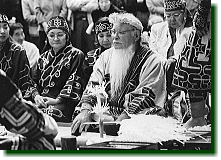 |
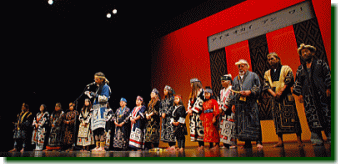 |
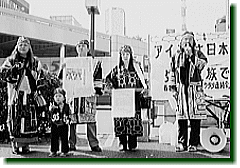 |
Ainu Ceremony
at a festival |
Greater Tokyo Ainu Festival (2008.06.08)
(Photo Maki Yanagimachi) |
Petition Drive
(Photo Maki Yanagimachi) |
|
|
  |
"TOKYO Ainu" Promotional Footage (You Tube)
|
 |
 |
|
  |
The film was completed with your support, but we still need to raise funds
to cover the production cost by means of extensive drive for screening
the film. We need your further support such as purchasing the screening
right, provision of information useful for film publicity and distribution
of screening information to media.
|
 |
| Step1 |
Send the Request Form for screening TOKYO Ainu by mail, fax or e-mail.
|
|
*Please retain a copy of the completed Form for future reference.
→Click here for downloading the Request Form.
|
| Step2 |
We will confirm the contents of the request and notify you of the screening
fee and the quotations of publicity materials.
|
|
?Screening fee: 50,000 yen for a screening with a seating capacity of up
to 100. The fee for screenings for a larger audience is not fixed subject
to consultation in consideration of audience size and other conditions.
|
|
?A2 color poster: 60 yen @piece
(with a space for printing screening details)
|
|
?A4 flyer (both sides printed in color): 5 yen @piece The front has a space
for printing screening details.
|
|
?Pamphlet: 60 yen @piece
(A4 16 pages in color, with Ainu history timeline, explanation of Ainu
related terms and information on current indigenous situations in Japan
as well as abroad. Essential to understanding the film.)
|
|
?Postage
|
| Step3 |
After screening details are confirmed, posters and flyers will be sent.
|
| Step4 |
The DVD for screening and pamphlets will be sent 5 to 7 days prior to the date of screening.
|
| Step5 |
The number of audience will be notified to us after the screening and the DVD will be returned within 7 days after the screening. (The single figure of the audience number can be rounded down.)
|
| Step6 |
The bill will be sent accommodating the returned pamphlets
|
| Step7 |
Bill payment
|
●Contact●
Tokyo Ainu Film Production Committee
TEL&FAX:+81-045-472-6349
E-mail
|
Payment (via Paypal)
|
| Screening Fee & promotional materials >> |
|
|
 |
Japan Post Bank
Account: 00150-2-632153
"TOKYO Ainu" Eizo Seisaku Iinkai
|

|
|
|
|
|